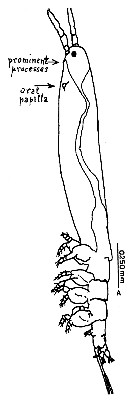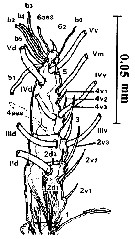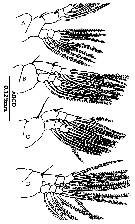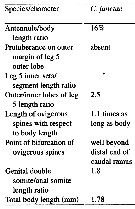|
|
 |
Fiche d'espèce de Copépode |
|
|
Monstrilloida ( Ordre ) |
|
|
|
Monstrillidae ( Famille ) |
|
|
|
Cymbasoma ( Genre ) |
|
|
| |
Cymbasoma janetae Mageed, 2010 (F) | |
| | | | | | | Ref.: | | | Mageed, 2010 (p.515, Descr.F, figs.F) |  issued from : A.A.A. Mageed in Crustaceana, 2010, 83 (5). [p.516, Fig.2]. Female (from 34°43'N, 29°10'E): habitus (lateral). Nota: Cephalothorax representing 71 % of total body length; cephalothorax without any obvious cuticular surface ornamentation. Oral papilla located at 17 % along ventral surface of cephalothorax from anterior end. Proeminent processes between oral papilla and bases of A1. Eye present, well-developed. Forhead smooth. Urosome 3-segmented (pedigerous somite 5, genital-double-somite and 1 free somite). P5 with inner, finger-like endopodal lobe, parallel to exopodal lobe. Exopodal lobe twice as long as wide, with 3 setae, innermost about half the length of the other two. Genital double-somite slightly shorter than one-third of total length of urosome (32.4 %), ventral portion swollen posteriorly, bearing 2 long ovigerous spines, 1.1 times total body length, fused proximally from base to beyond caudal rami Caudal rami 1.37 times as long as wide, moderately divergent, bearing 3 terminal setae
|
 issued from : A.A.A. Mageed in Crustaceana, 2010, 83 (5). [p.519, Fig.4]. Female: Left A1 (dorsal aspect). Designation of armature elements follows Grygier & Ohtsuka (1995). Nota: A1 4-segmented, about 13.5 % of total body length and 1.9 times as long as cephalothorax. Element 1 is present on the 1st segment; elements 2d1, 2d2, 2v1, 2v2, 2v3 and IId on the 2nd segment; the 3rd segment has elements 3, IIId and IIIv; 4th segment has normally developed elements 4v1, 4d1,2 and 4v2-3, as well as setae IVd, Ivv, Vd and Vm and also element 5. The subterminal elements b1-6 are present. The aesthetasc 4aes is well developed on the ventral surface, and terminal elements 6aes and 6 (2) are present. Element 6 (1) was not observed (may be broken).
|
 issued from : A.A.A. Mageed in Crustaceana, 2010, 83 (5). [p.518, Fig.3]. Female: A-D, P1 to P4 (right legs, posteriorly)
|
 issued from : A.A.A. Mageed in Crustaceana, 2010, 83 (5). [p.517]. Female: Armature of swimming legs P1 to P4 (spines in Roman and setae in Arabic numerals).
|
 issued from : A.A.A. Mageed in Crustaceana, 2010, 83 (5). [p.520, Pl. 2]. Female: A, genital double-somite; B, caudal rami and ovigerous spine base. Nota: Eight shallow, transverse cuticular wrinkles present on lateral margin and dorsal surface of genital double-somite
|
 Issued from : F. Üstün, T. Terbiyik Kurt & E. Suarez-Morales in Crustaceana, 2014, 87 (11-12). [p.1403, Table I]. Taxonomic features and morphometry of females of Cymbasoma janetae.
|
 Issued from : F. Üstün, T. Terbiyik Kurt & E. Suarez-Morales in Crustaceana, 2014, 87 (11-12). [p.1404, Table I (continued)]. Taxonomic features and morphometry of females of Cymbasoma janetae.
| | | | | Ref. compl.: | | | Üstün & al., 2014 (p.1402, 1408 Table I) | | | | NZ: | 1 | | |
|
Carte de distribution de Cymbasoma janetae par zones géographiques
|
| | | | Loc: | | | Red Sea (N Gulf of Aqaba: Ras Burka) | | | | N: | 1 | | | | Lg.: | | | (1082)* F: 1,78
* measured in dorsal view (caudal rami excluded) | | | | Rem.: | For Mageed (2010, p.520) the species is most similar to C. longispinosum (Bourne, 1890), also similar to C. morii Sekiguchi, 1982, C. chelemense Suarez-Morales & Escamilla, 1997, and C. californiense Suarez-Morales & Palomares-Garcià, 1999 mainly in the presence of the dorsal cuticular wrinkles on the genital double-somite in addition to the other characters that distinguish it from C. longispinosum.
This form is assignable to Cymbasima longispinosum species-group. | | | Dernière mise à jour : 09/10/2015 | |
|
|
 Toute utilisation de ce site pour une publication sera mentionnée avec la référence suivante : Toute utilisation de ce site pour une publication sera mentionnée avec la référence suivante :
Razouls C., Desreumaux N., Kouwenberg J. et de Bovée F., 2005-2025. - Biodiversité des Copépodes planctoniques marins (morphologie, répartition géographique et données biologiques). Sorbonne Université, CNRS. Disponible sur http://copepodes.obs-banyuls.fr [Accédé le 24 octobre 2025] © copyright 2005-2025 Sorbonne Université, CNRS
|
|
 |
 |









